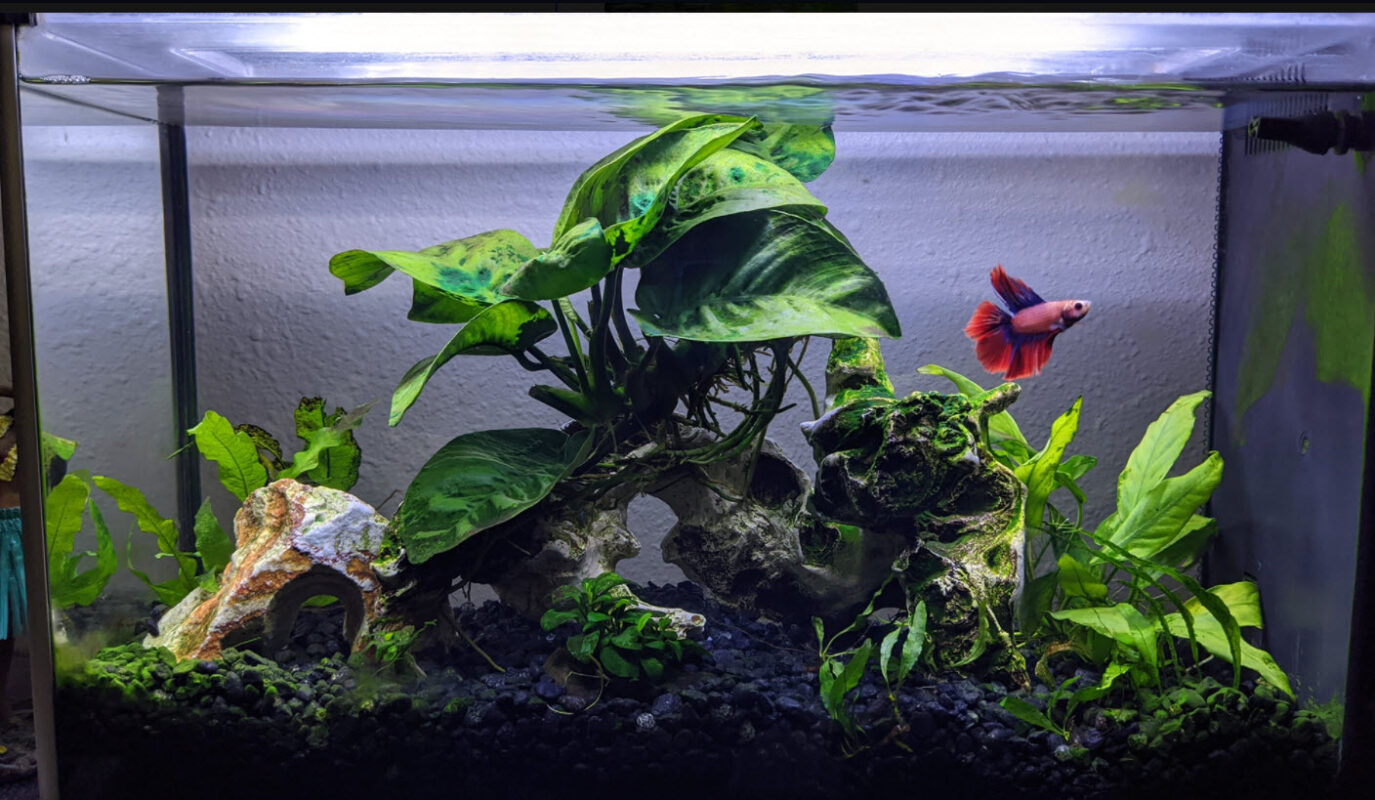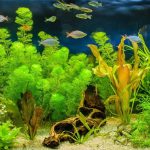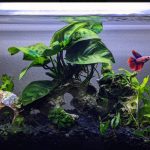Betta fish are popular for their vibrant colors and flowing fins, making them one of the common choices of aquarists. However, every aquarist with a betta in their tank experiences some kind of difficulty with the aquarium plants. This is mainly because they do not work on finding the compatibility between aquarium plants and betta fish.
Creating a suitable environment for these majestic creatures goes beyond just providing clean water and appropriate tank size. One crucial aspect often overlooked is the inclusion of compatible aquatic plants within the betta’s habitat.
Factors to consider while choosing plants for betta fish aquarium
When it comes to the tank’s environment, it is important to consider what betta fish prefer. For instance, bettas favor a warm and relatively calmer ecosystem where the water flow rate is slow and steady. At the same time, these fish often take breaks to rest and thus require ample zones and shades to hide out and relax.
Other than these factors, one of the aesthetics of bettas is their broad and big flowing fins. Therefore, having plants with smooth and soft leaves will ensure that nothing will get damaged- neither the delicate fins of betta nor the leaves of the aquatic plants. Likewise, you should not ignore the nipping behavior of betta; therefore, try to keep relatively hardy plants to keep their leaves well protected from the fish.
Additionally, selecting the aquarium plants whose water requirements are almost similar to those of betta fish is utmost important. In this way, both will survive without struggling.
Keeping all these criteria in mind, we have selected the ten most compatible aquarium plants for the betta fish. Keep reading to find them out!
1. Java Fern
• Botanical name: Microsorum pteropus
• Water Temperature: 20-28°C
• pH level: 6.0 and 7.5
• Lighting requirement: Low to moderate lighting conditions
Java Fern is one of the best beginner friendly aquatic plants that you can get for your Betta tank. With its overall low water requirements, it is suitable for all types of aquarists. Also, is easy to care and maintain and performs well in freshwater tanks where you will keep the betta.
The good thing about Java Fern is that it acclimatizes well to the water requirements of the Betta fish tank, ensuring that you don’t have to make many adjustments to the water parameters. At the same time, the light requirements of Java Fern are low, which means there won’t be any requirement to install an extra LED system for its growth.
Java Fern is a slow grower. It means as the plant grows, it gives ample of time for the betta to adjust through its growing leaves. Adding fertilizers will make the leaves go broader. The good thing about these broad leaves is they will provide enough hiding space for the fish, creating a perfect habitat for them. Plant Java Fern by allowing it to root on the driftwood or rocks by fixing them using fishing line or super glue.
2. Hornwort
• Botanical name: Ceratophyllum demersum
• Water Temperature: 10°C to 28°C
• pH level: 6 to 7.5
• Lighting requirement: Low to moderate lighting conditions
Even though, for beginners, Hornwort may seem slightly tougher to raise than Java Fern, it is one of the great plants to grow in betta fish tank. Still, aquarists with little experience in cultivating aquarium plants can go for Hornwort without any second thoughts.
Its highly adaptable nature is what makes it feasible for betta fish tanks. Its low light requirement and ability to thrive perfectly in a wide range of temperatures ensure that you won’t find it hard to maintain it.
One thing that you need to keep in mind is hornwort multiplies very fast. Due to the rapid growth rate, you may end up getting a lot of plant material in the tank, which will result in a good amount of left-behind foliage that will require a regular cleanup. Regular pruning will keep this mess manageable.
You can skip adding fertilizers with Hornwort, but if you are adding them, do not go overboard. This plant grows tall, giving a good space for betta fish to swim and hide across it. Besides all these, hornworts adjust to the water conditions of betta perfectly well, making them suitable for this pretty fish.
3. Java Moss
• Botanical name: Taxiphyllum barbieri
• Water Temperature: 15°C to 28°C
• pH level: 6.0 and 7.5
• Lighting requirement: Low to moderate lighting conditions
One of the simplest and no-brainer aquarium plants with many adaptable features that are suitable for betta fish tanks is Java Moss. Neither does it require too much maintenance, nor does it have huge requirements. All that Java Moss needs is regular pruning so that it doesn’t cover the entire tank.
Java Moss is a low-light, required aquarium plant that grows at a good rate. However, if you are seeking plants that provide coverage to betta with large or broad leaves, Java Fern will not fulfill this needs. But they do cover up the tank with their filamentous-like growth.
Thus, Java Fern will create a blanket for Betta tanks and you end up getting a green carpet floor for the aquarium which looks extremely pleasing. Another benefit of growing Java Moss is it helps to improve the quality of water by escalating its oxygen. Thus, your loving fish will breathe better in their environment.
Java Moss is easy to plant and propagate. Just attach it to rocks and wood or let it float freely.
4. Anacharis
• Botanical name: Egeria densa
• Water Temperature: 15°C to 25°C
• pH level: 6.5 to 7.5
• Lighting requirement: Low to moderate lighting conditions
There are many benefits of including Anacharis in your betta fish tank among which one is its size. It is a large aquarium plant whose leaves are known best for water filtration and oxygen generation. Thus, it improves the breathability in tanks. Anacharis also helps control algae in the tank as it releases oxygen and absorbs nutrients readily.
So, if you want to keep your betta fish healthy by keeping them in oxygen-rich water, make sure you include aquarium plants like Anacharis.
Regarding its water requirements, Anacharis can thrive in a wide range of water temperatures. From a temperate climate to warmer Betta waters, it will live healthily. Adding fertilizers will help the plant to grow well and flourish. At the same time, you need to trim the plant occasionally to ensure it doesn’t proliferate abruptly. Anacharis give good shade to betta fish and deliver enough oxygen to the water.
It is easy to plant Anacharis. You can do it either by hanging out the plant in water column or simply root it down in the substrate. You can also tie it to driftwood or rocks in the tank.
5. Amazon Sword
• Botanical name: Echinodorus amazonicus
• Water Temperature: 22°C to 28°C
• pH level: 6.5 and 7.5
• Lighting requirement: Moderate to high light requirements
Amazon Sword is one of the hardy plants that Betta owners can have in their tank. With their easily adaptable nature, they thrive well in all types of aquariums. All that Amazon Swords need is proper lighting to proliferate. Besides, offering fertilizers and a fertilizer-rich substrate will ensure that Amazon Sword flourishes in your betta fish tank.
Supplementing a good amount of iron and carbon dioxide make sure that Amazon Sword will show its true growth and potential.
Since the leaves of the Amazon Sword are quite big, like a sword, make sure that the tanks are not small. A tank of at least 10-gallon size is needed for Amazon Sword. If the tank is small, you need to trim the leaves more often. So, if you have a large betta fish tank, Amazon Sword is your go-to option.
While the large leaves will provide good coverage for betta to hide and rest, the hardy nature will ensure that nipping won’t hurt.
6. Anubias
• Botanical name: Anubias spp.
• Water Temperature: 22-28°C
• pH level: 6 to 7.5
• Lighting requirement: Low to moderate lighting
Anubias is one of those aquarium plants that have multiple species. Other than Anubias nana, all the species have large leaves, providing enough space for the bettas to hide and rest. At the same time, their easy-to-care and maintenance nature makes Anubias best for beginners.
If you are cultivating larger species of Anubias, you might need to provide moderate to high light intensity. Otherwise, low light is sufficient to help it thrive. There is no requirement for pruning or trimming the plant as it is a slow grower.
Besides, their ability to adapt to varying water conditions and climates ensures you will not face any difficulty raising them with betta fish. All you need to care about is their propagation, which requires substrate like gravel. It is essential not to suffocate the roots of Anubias, or else they may wither and die. You can use driftwood or rocks to root the plant.
7. Dwarf Hairgrass
• Botanical name: Eleocharis parvula or Eleocharis acicularis
• Water Temperature: 21-28°C
• pH level: 6.5-7.5
• Lighting requirement: Moderate to high lighting
The fine grass-like appearance of dwarf hairgrass is what makes it extremely appealing. It creates a carpet on the tank that makes it perfect for increasing the aquarium’s aesthetic. It is highly used by the aquarists for tank decoration.
Another good thing about dwarf hair grass is it doesn’t require too much care or maintenance. Just like betta fish, it also thrives in warmer climatic conditions, so you don’t need to put any extra effort into adjusting the water temperature. All that you need to care about is supplementing fertilizers to promote the plant’s growth.
Since dwarf hairgrass grows as a carpet, it doesn’t have large or broad leaves to hide betta fish. But adding it to the tank will ensure that the fish will enjoy in a greener and more pleasant atmosphere, breathing better in a cleaner water.
8. Water Wisteria
• Botanical name: Hygrophila difformis
• Water Temperature: 21-28°C
• pH level: 6.5-7.5
• Lighting requirement: Moderate to high lighting
This is one of the tropical aquarium plants that prefer warmer water temperature just like betta fish. Talking about its light requirements, when supplied with moderate to high light conditions, the plant thrives. However, it also grows under low light conditions.
The best part about Water Wisteria is you can put it in a tank or plant it on a fertilizer-rich substrate. In both ways, this plant will thrive wonderfully in the tank. Water Wisteria looks elegant and delicate, and it easily fills the aquariums. At the same time, these plants grow large, giving enough space for bettas to hide and play.
Since Water Wisteria can grow up to two feet or more, make sure the aquarium is at least 10 gallons in size. If you want to make this plant the centerpiece of the tank, it will require high lighting to get bigger for the center.
9. Marimo Moss Ball
• Botanical name: Aegagropila linnaei
• Water Temperature: 5°C to 25°C
• pH level: 6.0 and 8.0
• Lighting requirement: Low to moderate indirect light
Marimo Moss Ball is the best bet for all those aquarists who have a small tank with betta fish. Some call it a plant, others take it as a plant accessory, but these balls could be a great addition to the tank. Technically, they are not moss or aquarium plants but live balls of good algae.
Besides increasing the tank’s aesthetic, the Marimo Moss Ball doesn’t require much care and can last in the tanks for years. At the same time, their requirements are the same as those of betta fish. Also, they offer the same benefits as any regular aquarium plant does. Betta fish love to lie around these Moss Balls and even nap over them.
Another good thing about these balls is you don’t have to plant or root them in the substrate. All you need is to place them inside the tank and rinse them once in a while.
10. Amazon Frogbit
• Botanical name: Limnobium laevigatum
• Water Temperature: 18°C to 28°C
• pH level:6.0 and 7.5
• Lighting requirement: Moderate to bright indirect light
Amazon Frogbit is a popular floating aquarium plant that provides good shade for betta fish. Creating jungle-like appearance in the tank, this plant needs regular trimming. However, it ensures great coverage. With regular trimming, the plant may overcrowd the tank.
The long and thick roots of Amazon Frogbit provide enough space for betta fish to hide, play, rest and keep their eggs safe. The growth rate of the plant is relatively fast, and it doesn’t require much effort.
Amazon Frogbit requires light of high intensity for at least three hours for flourishing. There is no need of substrate but good amount of fertilizer.
Conclusion
Every fish has a unique water requirement, and when you add plants that match it, both the species of flora and fauna live happily. These plants are suitable for betta fish tanks as they adapt and adjust to the same water requirements as that of betta fish. At the same time, some of the plants provide good hiding and resting places for the betta fish due to their large leaves.
So, if you are planning for a betta tank, consider these aquarium plants, as they are the most compatible and suitable for Betta fish.





